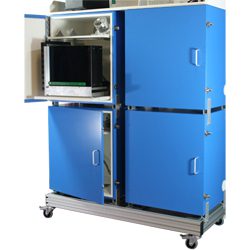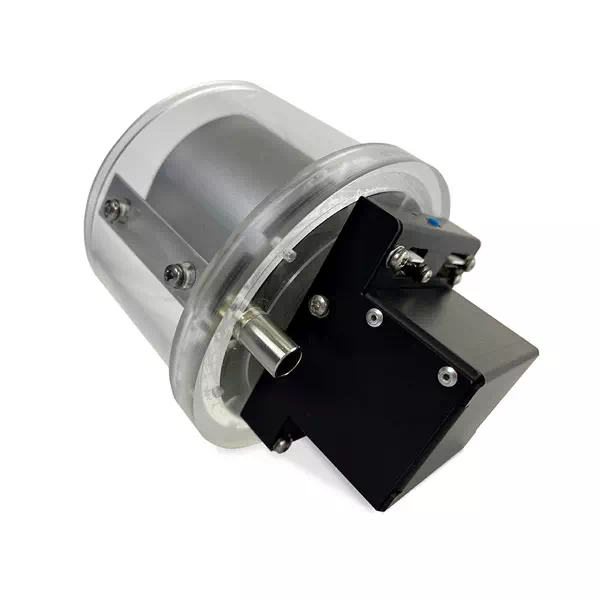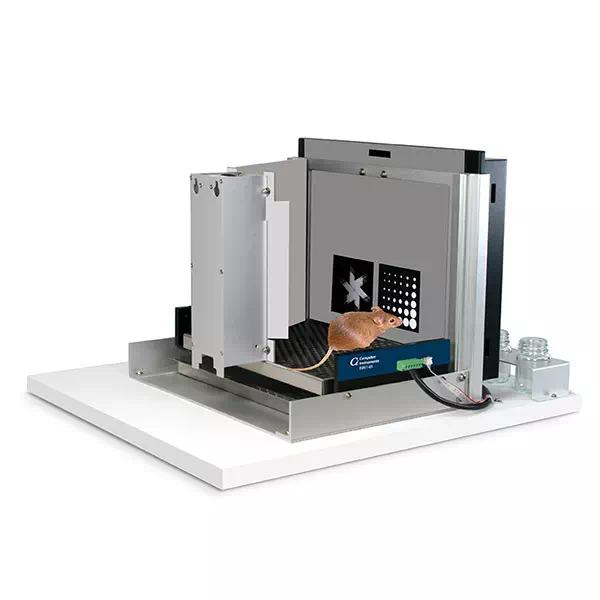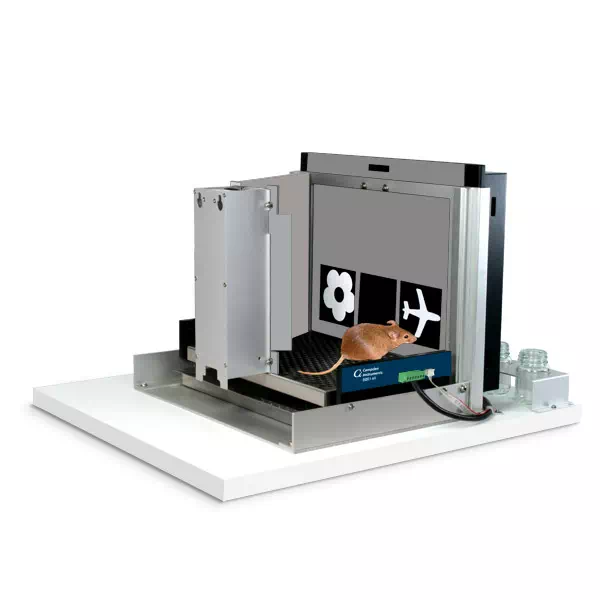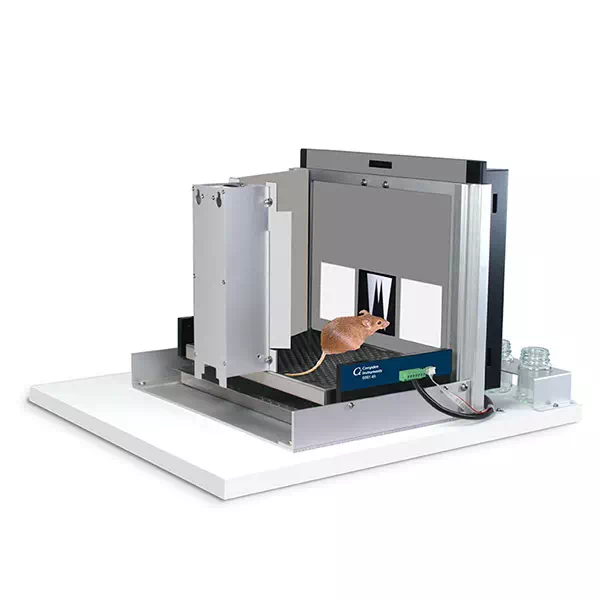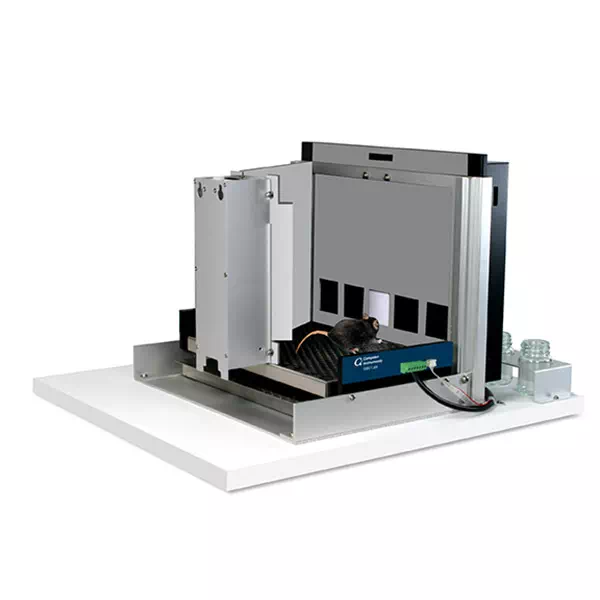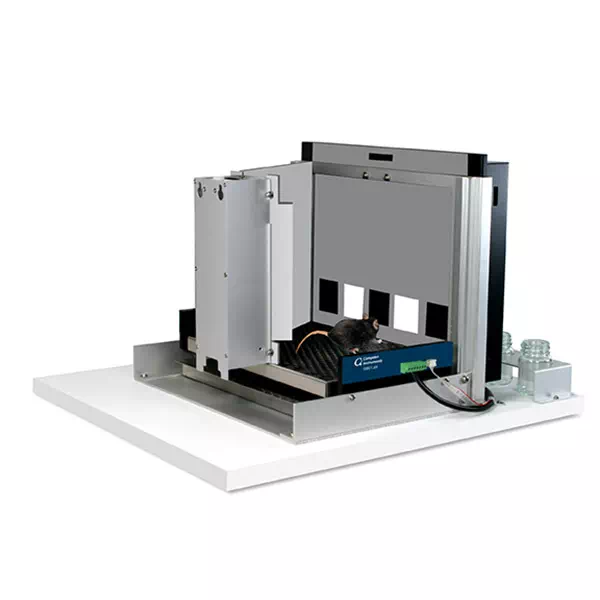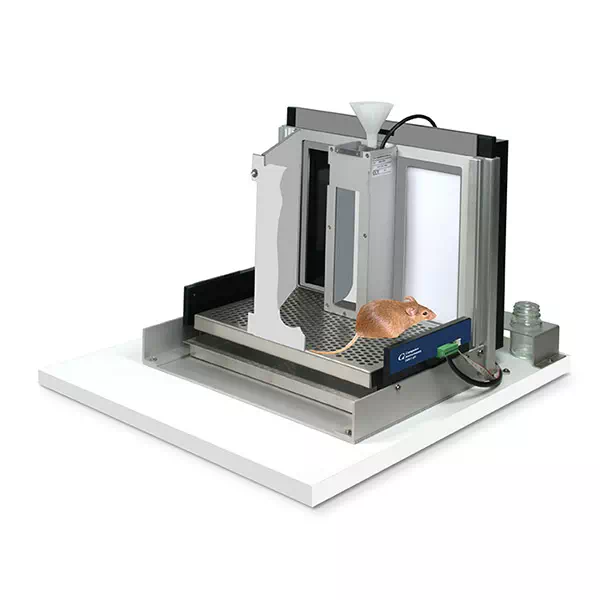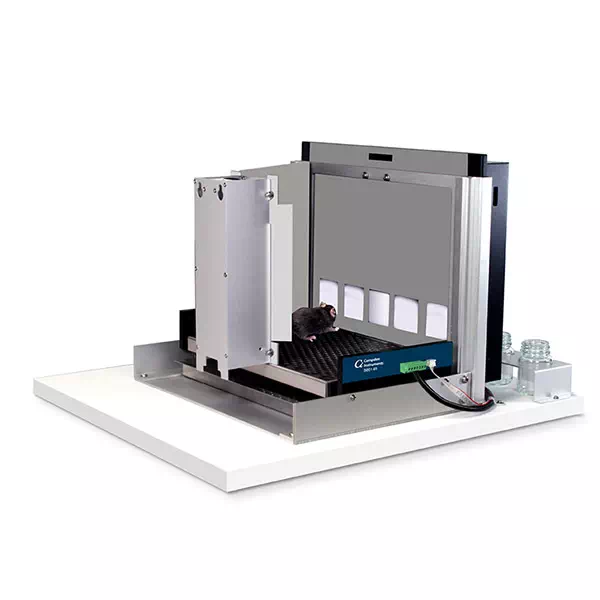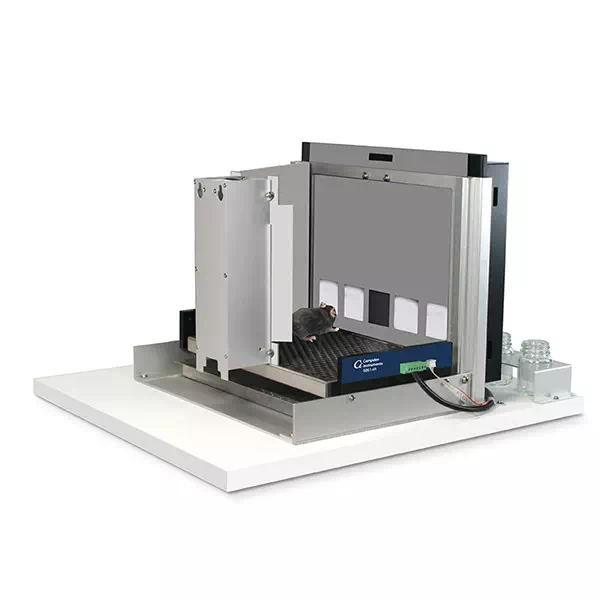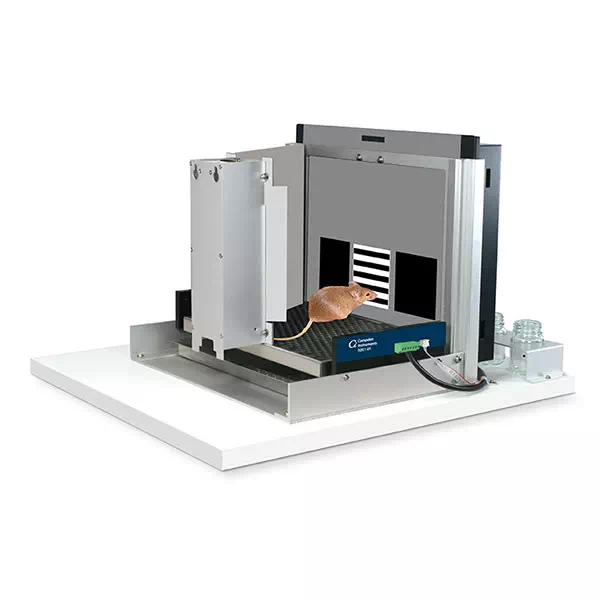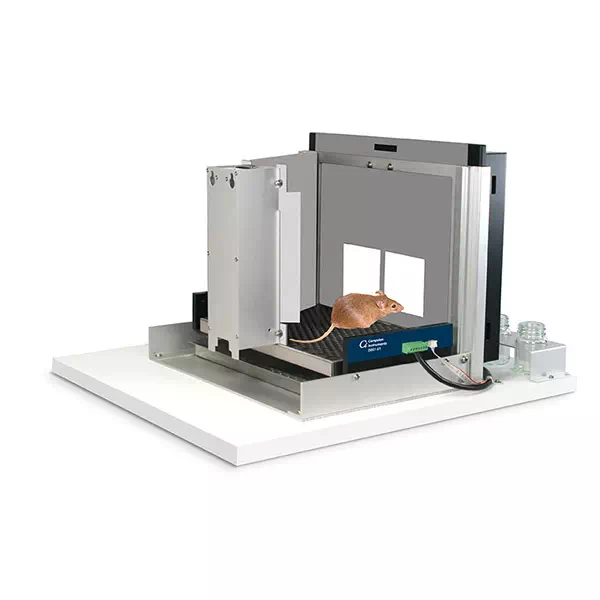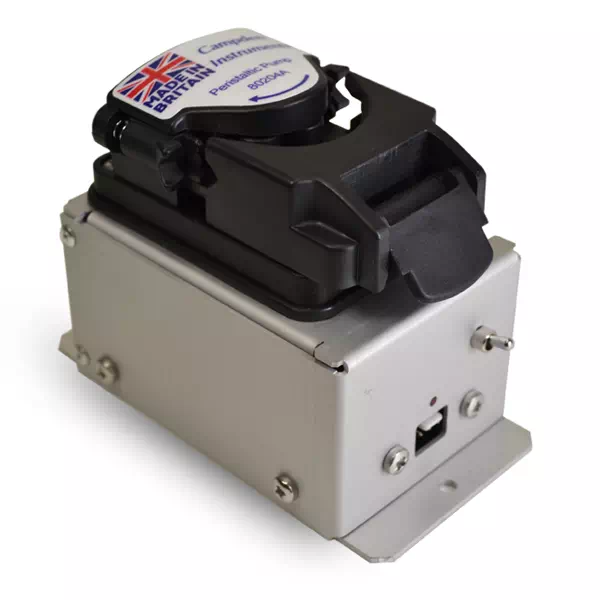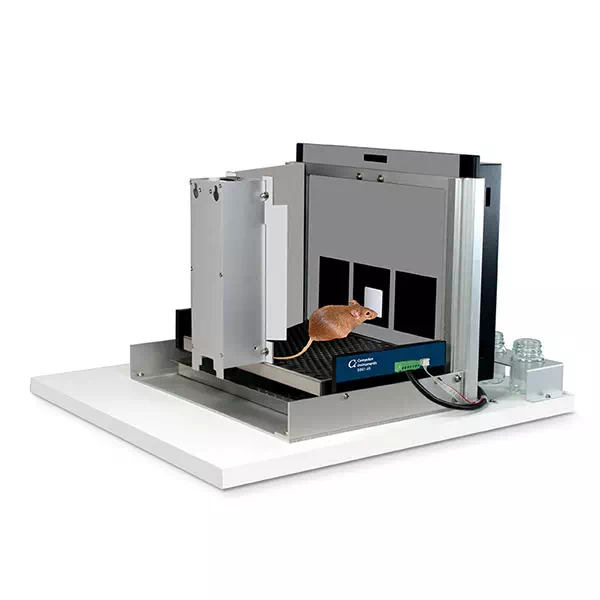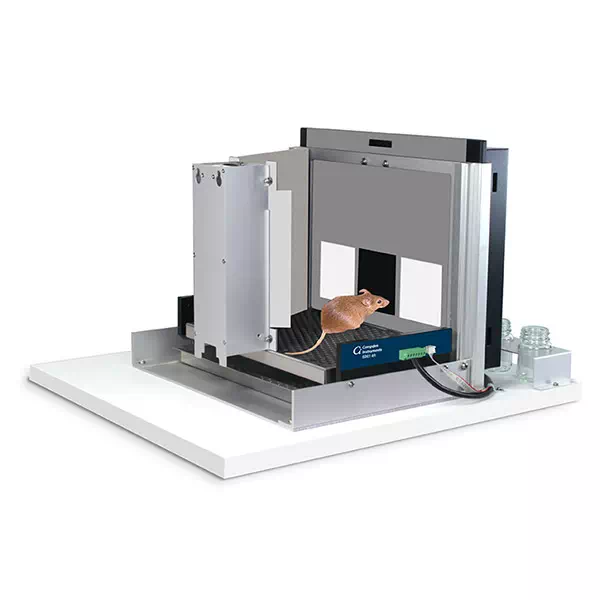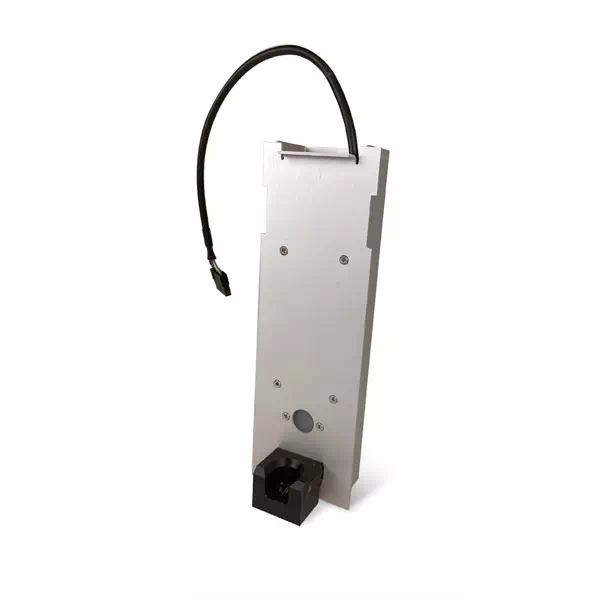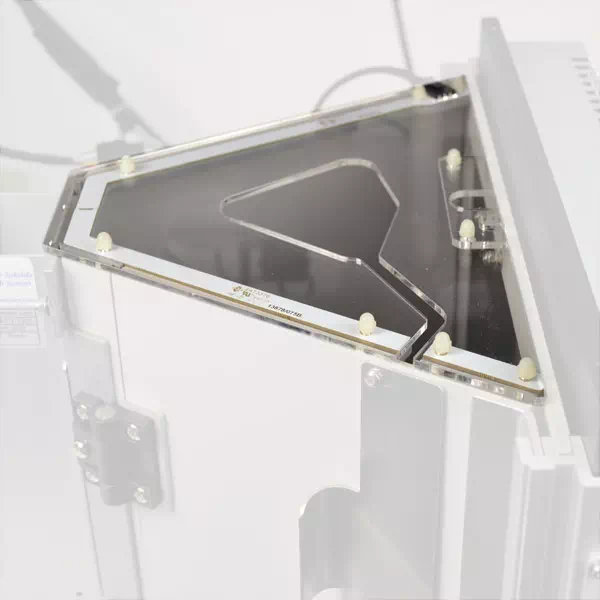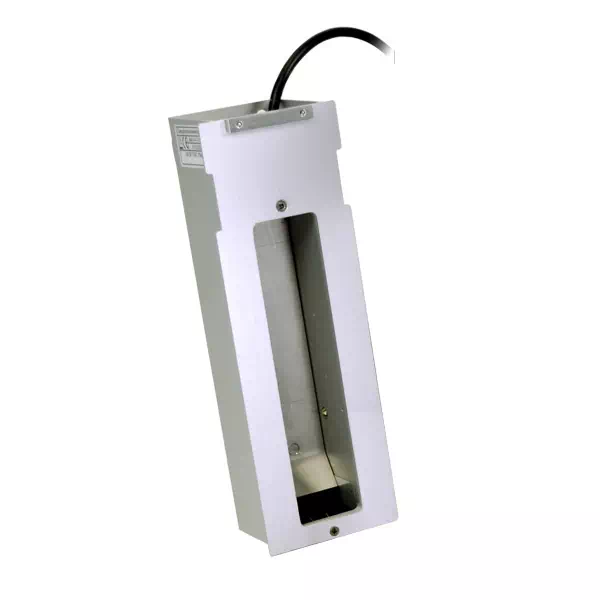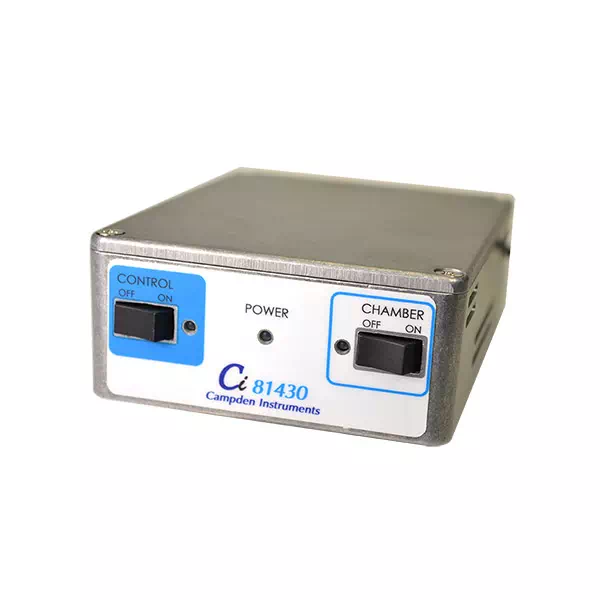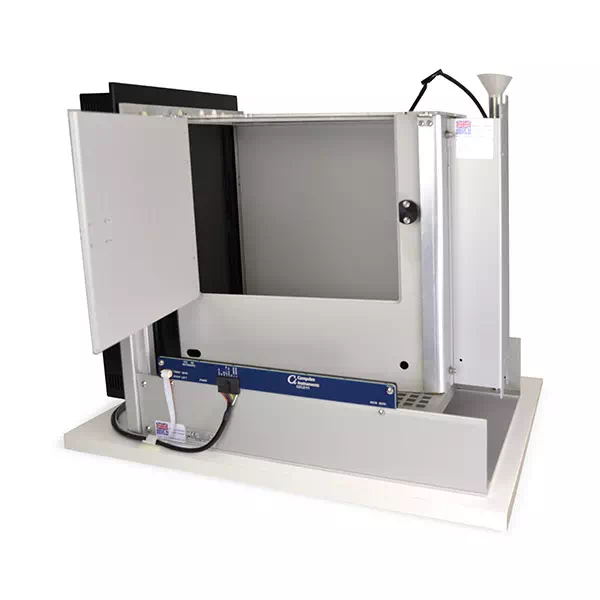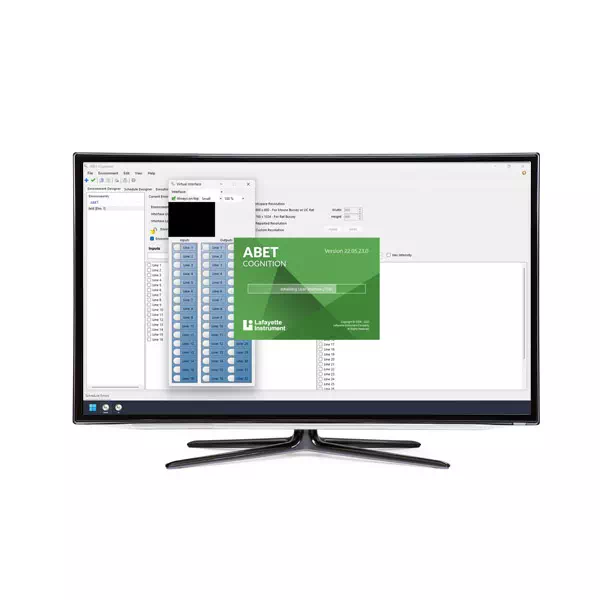A Decade of Continuous Touch Screen Development
First developed at Cambridge University, Bussey-Saksida Rodent Touch Screen Chambers are now used by +300 research groups in over 26 countries. The Bussey-Saksida Chamber has always featured a unique trapezoidal wall shape in order to focus the animal’s attention and facilitates the efficient and high-throughput cognitive evaluation of rodents. The chamber is easily reconfigured to a modular square arena with panels, levers, lights, and a range of other operators to accommodate any task like an operant chamber equipped with a traditional lever or nose-poke.
Evolution: Meet the New Bussey-Saksida Chamber

Video
The Second Generation Bussey-Saksida chamber was built with video in mind. New non-reflective walls and floors will aid video tracking, and IR and ambient lighting located under the chamber lid provide even lighting of the chamber and eliminate glare.
Tethered Animals
Many accommodations for tethers can be made including updated lid and open reward areas to accommodate headstages. A convenient sliding drawer can be added to the environmental cabinet to neatly store and feed the tether.
Electrophysiology
All electronic components are adjusted to reduce EMC. The environmental cabinet is a Faraday cage to prevent outside noise from the surrounding area from entering the chamber. Even the touch screen itself is shielded to reduce noise emission.
Chamber Inclusions
Plug-n-Play Productivity
Paradigms
The Bussey-Saksida chamber allows usage of standard, original, and customized paradigms.
Standard Task Paradigms are available by arrangement with the University of Cambridge. Standard tasks include popular Tasks such as PD, PAL, 5CSRT, PRC, Location Discrimination, and many more. The rodent tasks range from simple to complex and are virtually identical to tasks used with NHP & human populations on the CANTAB system.
All paradigms include training routines as well as the main experimental paradigm and the data analysis sets.
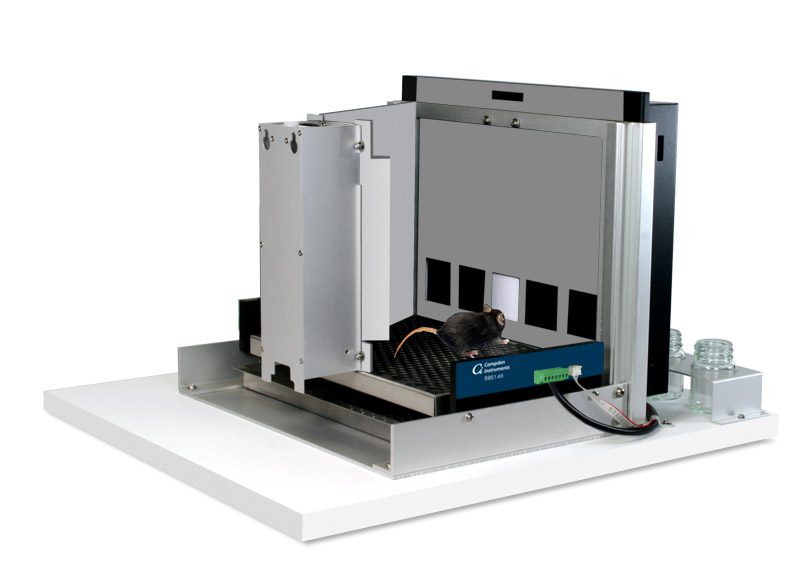
| NHP/Human CANTAB Equivalent | Standard Tasks | Typical time to reach baseline | Example neural systems involved | Clinical area showing impairment |
| NHP | Pretraining to touch an image and initiate a trial (All task except Auto and 5CSRT) | 1-2 weeks (e.g., 7-8 week old C57BL6J mice: 5 days) | Learning | |
| Human/NHP | Pairwise / Visual Discrimination (PD) and Reversal Learning | Pretraining + 5-7 sessions test to reach base line | Prefrontal Cortex, Perirhinal Cortex, Anterior Cingulate, Posterior Cingulate, Medial Frontal Cortex, Striatum, Dopamine system, Cholinergic system, NMDA receptors. Mediodorsal Nucleus of the Thalamus | Huntington’s, Schizophrenia, Parkinson’s, Learning, Cognitive Flexibility, Executive Function. |
| Human/NHP | Paired-Associate Learning Task for Rodents (PAL) | Pretraining + 35-45 sessions to 70% | Hippocampus, Cholinergic system, NMDA Receptors, AMPA Receptors | Alzheimer’s, Schizophrenia, Spacial Memory |
| NHP | Visuomotor Conditional Learning for Rodents (VMCL) | Pretraining + Approximately 20 sessions | Dorsal Striatum, Posterior Cingulate Cortex | Huntington’s, Parkinson’s |
| Human/NHP | 5-choice Serial Reaction Time Task for Rodents (5CSRT) | Pretraining (ave 10 sessions) + 3 weeks to 80% @ 2 sec baseline | Prefrontal Cortex, Basal Forebrain, Cholinergic (Accuracy), Serotonin (Impulsivity), Noradrenaline (Distraction), Dopamine (Motivation) | Alzheimer’s, Depression, Huntington’s, Schizophrenia, ADHD, OCD |
| Autoshaping for Rodents (Auto) | Several sessions (no pretraining required) | Ventral Striatum, Amygdala, Anterior Cingulate Cortex, Nucleus Accumbens Dopamine, Pedunculopontine Tegmental Nucleus, D1 and NMDA receptors | Huntington’s | |
| Human/NHP | Trial-unique Nonmatching-to-Location Task for Rodents (TUNL) | Pretraining + 6-24 Sessions to acquire the basic task | Hippocampus, Cholinergic system, NMDA Receptors, Prefrontal Cortex | Alzheimer’s, Schizophrenia |
| NHP | Location Discrimination for Rodents (LD) | Pretraining + 10-20 sessions | Hippocampus, Neurogenesis | Alzheimer’s, Schizophrenia |
| NHP | Extinction for Rodents (EXT) | Approximately 4 sessions training + a sessions days extinction | Infralimbic Cortex, Striatum and Amygdala | ADHD, OCD |
| Human | 5-Choice Continuous Performance Test for Rodents (5C-CPT) | Approximately 13 sessions (based on training in 5-hole box) after training to 5-CSRTT | Dopamine, Serotonin, Cholinergic, Parietal, Muscarinic. | Schizophrenia, ADHD, OCD, Alzheimer’s |
| NHP | Progressive Ratio and Effort Related Choice Task for Rodents (PR/ERC) | 16 sessions from first habituation to reach stable PR performance | Dopamine | Motivation, Decision Making |
| Human | 4-Choice Gambling Task for Rodents (4C-GT) | Pretraining + 4 sessions familiarizing with choices available, then 13 sessions testing | Dopamine, Serotonin | Bipolar Disorder, Gambling, Depression, OCD, ADHD, Parkinson’s, Schizophrenia, Impulsivity |
| Human/NHP | Rodent Continuous Performance Task: Image for Rodents (rCPT) | Pretraining + Approximately 30 sessions | Cholinergic system, Anterior Cingulate Cortex | Schizophrenia, ADHD, OCD, Alzheimer’s |
| Human | Delay Discounting for Rodents (DD) | Pretraining + approximately 13 sessions | Dopamine | Impulsivity, ADHD |
| NHP | Probabilistic Reversal Learning for Rodents (PRL) | Pretraining + Approximately 17 sessions | Serotonin | Depression |
Key Features
Design & Construction
- Durable, cost-effective build for long-term reliability.
- Modular chamber design minimizes reconfiguration between studies.
- Optional square modular walls allow the addition of levers or other modules.
- Slotted lids accommodate tethered animals.
- Shockable floor available.
Animal Handling & Ergonomics
- Easier animal handling with side or top loading as standard.
- Quiet magnetic-catch door for smooth, low-stress operation.
- Removable matted floor reduces glare and simplifies cleaning.
- Two interchangeable front plates with different aperture heights included.
- Reward trough supports pellet retrieval and dual liquid feeds, with a wider aperture for head-staged animals.
Imaging & Tracking Optimization
- Light-colored, non-reflective walls enhance contrast for camera-based tracking.
- Matted, non-reflective floor ensures consistent image capture under varied lighting.
- Even IR and ambient lighting beneath the lid eliminates glare and shadows.
- IR tracking beams include instant test mode, improved sensitivity, and extended lifespan.
Electrophysiology & System Integration
- Optional electrical isolation coating on all contact points (floor, trough, etc.) prevents movement artefacts.
- Fully compatible with optogenetics, photometry, video tracking, and electrophysiology recording.
- Integrates easily with third-party systems via TTL input/output lines and low-noise EMC design.
- Includes 14 validated training tasks plus the ability to create custom paradigms.
Specifications:
Animal Working Area
- 46mm Wide at Feeder,
- 238mm Wide at Screen x 170mm Deep (241.4 Sq. cm or 37.5 Sq. in)
- Working Area is 230mm in Height
Standard Environmental Cabinet
- Attenuation: Approx. 35dB
- Weight: 38 kg (empty)
- External Dimensions: 600mm Wide x 670mm Tall x 352mm Deep
- Internal Dimensions: 540mm Wide x 610mm Tall x 532mm Deep

